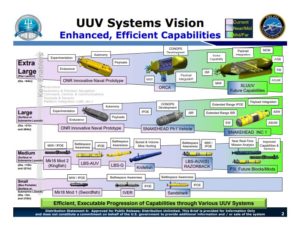The Navy said Wednesday its Office of Naval Research’s (ONR) Small Business Innovation Research (SBIR) program is expanding funding opportunities with more technology acceleration topics.
The SBIR program is expanding funding opportunities in a Broad Agency Announcement (BAA) “to solicit a wide range of potential small business partners” to expand capabilities in artificial intelligence, machine learning, autonomy, and training technology.
The latest BAA, titled 19.3, closes on Oct. 23 and aims to deliver prototype technologies within a year and a half to two years compared to the current schedule of three to four years.
SBIR generally provides the Navy with “groundbreaking technology advances from small companies by applying the agility and ingenuity of these businesses to the [Department of the Navy’s] research and development needs,” ONR said.
The new SBIR 19.3 technology acceleration topics include artificial intelligence (AI)/machine learning (ML) capabilities; Unmanned Surface Vehicle (USV) and Unmanned Underwater Vehicle (UUV) autonomous behavior and development; and advanced technologies (including augmented reality and virtual reality) for the manpower, personnel, training and education enterprise.
Specifically, the AI/ML capabilities aim to address readiness and sustainment, unmanned aircraft systems autonomy and automation, predictive maintenance, cyber, counter-AI, streamline business operations, integration of automatic dependent surveillance, integration of Automatic Identifications System data through AI/ML applications, and C4ISR.
The Navy’s unmanned vehicle topic is seeking a “broad range of emerging technologies” that can use AI and/or ML to help USVs and UUVs perform their missions without communicating with a distant control station. Focus areas include storm avoidance and in-storm maneuvering for USVs, perception, in-stride detection of sensor degradation, automated pattern and anomaly recognition, and classification of surface and subsurface vessels.

SBIR generally solicits proposals three times annually through BAAs. Selected companies get funding in three stages: Phase I, when a feasibility study is conducted to determine the scientific/technical merits of an idea; Phase I, a technology development phase when prototypes are built and tested; and Phase II, commercialization with sales of products to military and civilian markets.
The new 19.3 instead offers a revised application process that includes five times as many early stage Phase I awards per technology acceleration topic; streamlines proposals requirements from 20 to five pages; and evaluation, selection and payment processes that act 60 percent faster than previously.
It also features other tools to speed up SBIR awards. This includes how in May 2020 small businesses that can demonstrate Phase I feasibility of their technologies in person will be awarded same-day Phase II contracts. It will also offer select awardees “business-accelerator” services like incubation labs focused on particular naval interests.
“SBIR is now simpler, faster and more impactful. This revamped BAA enables us to adopt technology at the pace of today’s innovators. In short, SBIR companies are building our future naval advantage. Bring us your best ideas,” Chief of Naval Research Rear Adm. David Hahn said in a statement.
“We found more ways to make it easier to do business with us, which gives innovators more opportunities to become valuable Navy partners and successful commercial businesses,” SBIR Director Bob Smith added.
Relatedly, ONR said SBIR’s work with the Naval Expeditions (NavalX) Agility Office is an example of how it is trying to help connect small businesses to accelerate naval technologies.
SBIR is serving as a technology enabler of the Naval Expeditions (NavalX) Agility Office created by Assistant Secretary of the Navy for Research, Development and Acquisition James Geurts.
ONR underscored one product of this partnership is onsite SBIR expertise at NavalX’s recently announced five Tech Bridges (Defense Daily, Sept. 5).
NavalX was started as an innovation cell acting as a connector for ideas. The new tech bridges are the first of several more planned to encourage collaboration and connections with non-traditional partners at regional Navy sites.
